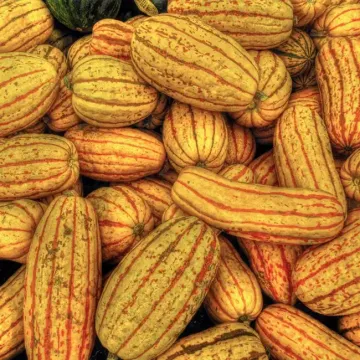Delicata squash, with its sweet, creamy flesh and edible skin, is a delightful addition to any home garden. Known for its unique oblong shape and pale yellow skin with green stripes, Delicata squash is often referred to as a "sweet potato squash" due to its rich flavor profile. Unlike many winter squashes, Delicata’s thin skin makes it easier to prepare without peeling. Growing this delicious vegetable can be rewarding, and here’s how you can cultivate it successfully in your garden.
History and Origin
Delicata squash is a variety of Cucurbita pepo, a species that also includes zucchini and other types of summer squash. First introduced in the early 1900s, Delicata fell out of favor during the mid-20th century due to its susceptibility to disease. However, it has made a comeback in recent years thanks to its excellent flavor and improved disease-resistant varieties.
Why Grow Delicata Squash?
- Flavor: Delicata squash is prized for its rich, sweet flavor, often described as a cross between a butternut squash and a sweet potato.
- Ease of Use: Its skin is tender enough to eat, making preparation easier than harder-skinned squashes like acorn or butternut.
- Versatility: Delicata can be roasted, stuffed, sautéed, or added to soups and salads, making it a versatile ingredient in the kitchen.
- Nutritional Benefits: This squash is a good source of dietary fiber, vitamins A and C, and potassium, all of which contribute to a healthy diet.
Planting Delicata Squash
Delicata squash is a warm-season crop that thrives in sunny, well-drained areas of your garden. Here are the steps to ensure a successful harvest:
- Timing: Plant seeds directly in the garden after the last frost date in your area when the soil has warmed to at least 70°F (21°C). Delicata squash requires a long growing season, typically around 80 to 100 days to mature.
- Soil Preparation: Delicata squash prefers well-drained, fertile soil with a pH between 6.0 and 6.8. Before planting, amend your soil with compost or well-rotted manure to improve its nutrient content.
- Spacing: Plant seeds 1 inch deep and space them 18 to 24 inches apart. If growing in hills, plant 3 to 4 seeds per hill and thin to the two strongest seedlings. Rows should be spaced about 6 feet apart, as the vines will spread out.
- Watering: Keep the soil consistently moist, especially during the flowering and fruiting stages. Water deeply at the base of the plant to encourage deep root growth, but avoid getting the foliage wet to minimize the risk of disease.
- Mulching: Applying a layer of mulch around your plants will help retain moisture and suppress weeds. Organic mulches such as straw or grass clippings are ideal for this purpose.
Supporting Growth
- Pollination: Like all squash plants, Delicata relies on pollinators such as bees to set fruit. Planting pollinator-friendly flowers nearby can encourage bee activity.
- Fertilization: Feed your plants with a balanced fertilizer, such as a 10-10-10 formula, when they begin to vine. Alternatively, side-dress with compost during the growing season to ensure they have access to necessary nutrients.
Common Pests and Diseases
Delicata squash can be susceptible to several common garden pests and diseases, so it’s important to be vigilant:
- Squash Vine Borers: These larvae can burrow into the stems, causing plants to wilt. To prevent them, consider using row covers early in the season and inspect the base of the plants regularly.
- Squash Bugs: These insects can suck the sap from your plants, causing them to weaken. Hand-pick adults and nymphs, and consider using neem oil or insecticidal soap as a treatment.
- Powdery Mildew: This fungal disease can affect squash leaves, leading to reduced vigor and yield. Ensure good air circulation around plants by spacing them properly and avoid overhead watering.
Harvesting Delicata Squash
Delicata squash is typically ready for harvest in late summer to early fall, around 80 to 100 days after planting. The squash should be a pale yellow color with vibrant green stripes, and the skin should be firm and difficult to puncture with a fingernail.
- When to Harvest: Harvest before the first frost, when the stems begin to dry out and turn brown. Use pruning shears to cut the squash from the vine, leaving about an inch of stem attached.
- Curing: Although Delicata has a shorter storage life compared to other winter squashes, curing the squash for about a week in a warm, dry location will help improve its shelf life.
- Storage: Store cured Delicata squash in a cool, dry place, where it can keep for up to three months.
Companion Planting for Delicata Squash
Companion planting can enhance the growth and health of Delicata squash. Consider planting the following companions:
- Corn and Beans: These are part of the traditional "Three Sisters" planting method, where the beans provide nitrogen, the corn offers support for beans to climb, and the squash shades the ground to retain moisture.
- Marigolds: Planting marigolds near your squash can help repel harmful insects like nematodes and squash bugs.
- Nasturtiums: These flowers can act as a trap crop, attracting aphids away from your squash plants.
Growing Delicata squash in your home garden is a rewarding experience that brings a unique and flavorful vegetable to your table. With proper care, attention to pests and diseases, and timely harvesting, you can enjoy a bountiful harvest of this sweet, delicious squash. Whether roasted, stuffed, or added to soups and salads, Delicata squash will add a rich, satisfying taste to your meals all season long.

